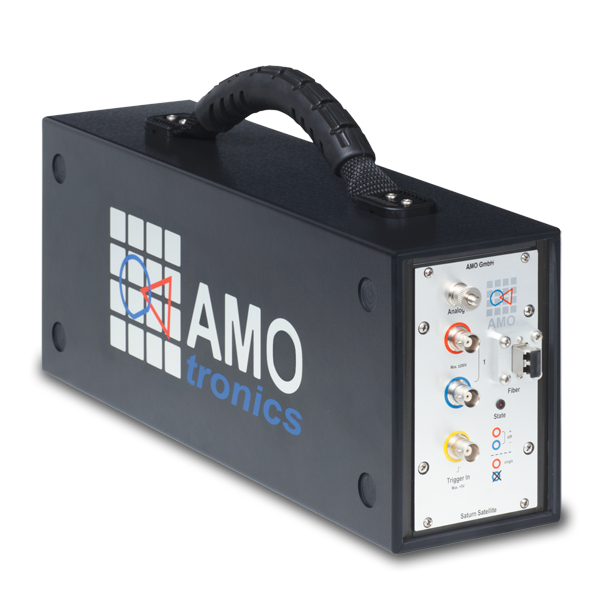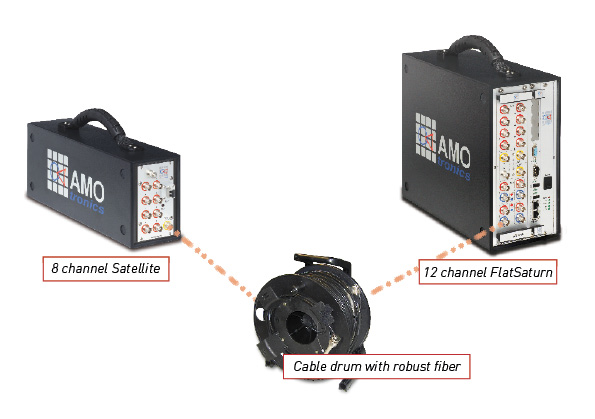SATURN Satellite - Fiber Coupled Measuring Probe

Alternatively to using built-in measurement modules the SATURN Transient Recorders can be equipped with fiber-optic modules. These modules are connected to external SATURN Measuring Satellites (see pictures) by means of a digital fiber-optic cable. The Satellites are remotely controlled from the SATURN base unit. The pure optical communication and data transfer ensures optimal galvanic isolation between the remote test probe and the SATURN base unit. These so-called fiber-optic transmission lines allow both, floating measurements as well as bridging large distances between test object and data recording system.
Use Case 1:
Optimal Isolation during High Voltage and High Power Measurements
Typical applications include high voltage tests and high power measurements on circuit breakers, transformers, relays, contactors, etc. (like MOSFET / IGBT tests to name only two popular examples). Studies on energy-storage systems (e.g. FuelCells), electric motors and generators as well as electro-magnetic accelerators (Electromagnetic Launcher, EML) also belong to this area of use. Within these applications the optical isolation between SATURN base unit and Satellites provides reliable protection against high voltages and high currents. The optionally enhanced shielding of the HV probe enables secure and accurate recordings of transient signals even under exposure of extreme electromagnetic fields.
Use Case 2:
Fast and Interference-Free Transmission of Measurement Signals Over Long Distances
In another field of application, the main focus is on bridging long distances, as for instance during ballistic experiments and explosion tests. The digital command and data transmission over fiber-optic cable allows distances of tens of miles/kilometers between the probe and measuring system, if needed. The SATURN Transient Recorder automatically compensates varying cable lengths and resulting differences in signal transmission times. This ensures synchronous data recording among all channels also in multi-channel applications.
Advantages over Traditional Fiber-Optic Transmission Lines
There exist different approaches for the fiber-optic transmission of measurement data. All solutions have in common that the data is being transferred via a fiber-optic cable. When using digital transmission lines the analog measurement signals are being digitized at the transmitter side and transmitted through the optical fiber cable to the receiver. At the receiver side the digitized signal is being further processed in different ways depending on the specific solution.
In the traditional approach, a separate receiver is being used to convert the optical signal back into analog electrical signals. The advantage of this solution is that the converted signals can be acquired by means of an ordinary oscilloscope or measurement device (e.g. with a SATURN Transient Recorder). However, the disadvantage is also obvious: the conversion back into analog signals and re-digitizing inevitably creates additional disturbances and loss of precision.
The SATURN Measuring Satellites have been developed as an alternative solution which avoids these additional conversions. Instead of using a separate receiver device the SATURN base unit is being equipped with fiber-optic modules (different types of cable connectors or a patch panel are available). This way the optical signal coming from the Satellite can be connected directly to the SATURN base unit. The fiber-optic modules immediately transmit the received digital measurement data into the memory of the SATURN system - without any conversion back to analog signals or re-digitizing. In addition the SATURN Satellites can be configured and operated directly via the user interface of the SATURN base unit which makes this solution especially comfortable (s. below).
Power Supply of SATURN Measuring Satellites
By default the SATURN Satellites are supplied with a single easily exchangeable and rechargeable battery. This makes it possible, for example, to raise the voltage level of the measurement probes to the voltage potential of the measurement object and to acquire the smallest voltage fluctuations at a level of several 100 kV or Megavolt. In addition a double-sized housing is available which can be equipped with two of those batteries. As soon as the charge of one battery is used up, the Satellite will automatically switch to the other one. For long-time measurements, the empty battery can be removed and recharged without interrupting the operation of the Satellite.
![]() A novel solution is the use of compressed air. In this case, the satellite is equipped with an integrated power generator. It allows continuous uninterrupted use, simply by connecting a compressed air line. This solution is particularly useful in applications where several satellites are placed at different measuring locations and where the locations of the satellites are not easily accessible.
A novel solution is the use of compressed air. In this case, the satellite is equipped with an integrated power generator. It allows continuous uninterrupted use, simply by connecting a compressed air line. This solution is particularly useful in applications where several satellites are placed at different measuring locations and where the locations of the satellites are not easily accessible.
As a third option the Satellites also can be prepared for external power supply (e.g. for connecting to a mains supply or a car battery).
Signal Conditioning and Sensor Powering
As another option the Satellites can be equipped with integrated amplifiers and sensor power supply for connecting virtually any active probe or sensor (e.g. Rogowski Coils). Other customizations are available on request, too.
Configuration and Operation
The SATURN system is being operated by means of the SATURN Studio II software. Using this software the configuration and operation of SATURN Fiber-Optic Satellites are as easy as of measurement modules which are fitted directly into the SATURN base unit. The software automatically detects all connected Satellites and keeps the user informed about their status. For example, in case of a weak battery it prevents the user from starting a measurement. Otherwise, there are no differences in operation. The measurement parameters which have been configured in the software are automatically transmitted to the Satellite. During the measurement, the digitized data is immediately transferred from the satellite over the fiber optic cable to the base unit and resists secure in the memory of the carrier board. The further processing of the collected data does not require any special treatment compared to data from a built-in measurement module. This high degree of integration between hardware and software makes the SATURN measurement system so easy to use and accordingly popular among its users.




